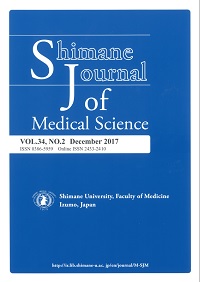Shimane University Faculty of Medicine
ISSN :0386-5959(in print)
ISSN :2433-2410(online)


These article are licensed under a Creative Commons Attribution-NonCommercial-NoDerivatives 4.0 International License.
number of downloads : ?
Use this link to cite this item : https://ir.lib.shimane-u.ac.jp/40811
Shimane Journal of Medical Science 34 3
2018-03-31 発行
Protection of Rat Retina Against Light-induced Damage by Intraperitoneal and Oral Administration of a Polyphenol Fraction From Seed Shells of Japanese Horse Chestnuts(Aesculus turbinata BLUME)
Ishihara, Tomoe
Department of Ophthalmology
Kaidzu, Sachiko
Department of Ophthalmology
KIMURA, Hideto
Kotobuki Seika Co., Ltd.
KOYAMA, Yasuro
Kotobuki Seika Co., Ltd.
MATSUOKA, Yotaro
Department of Ophthalmology
Ohira, Akihiro
Department of Ophthalmology
File
Description
Retinal light-induced damage model rats used
in age-related macular degeneration (AMD) studies
clarified that antioxidants decrease the damage.
The seed shells of Japanese horse chestnuts have
antioxidant activity with polyphenols. We studied
that protective effect of the polyphenols from lightinduced
damage. Polyphenols fraction (PF) was extracted
and separated from the seed shells. Antioxidant
activities of PF were measured. Intraperitoneal
administration (IP) and oral administration (PO) of
PF was evaluated protective effects by flash electroretinograms
(ERGs) and outer nuclear layer (ONL)
thickness measurement. IP of PF (100 mg/kg body
weight [BW] and phenyl N-tert-butyl nitrone (PBN)
(50 mg/kg BW) suppressed decrease of ERG amplitude
significantly. And then, decrease of ONL
thickness was suppressed by PF (25, 50 and 100
mg/kg BW) and PBN (50 mg/kg BW). PO of PF
(100 mg/kg BW) protects retinas from light-induced
damage, as well as PBN (10 and 50 mg/kg BW).
Our results indicate that PF alleviates light-induced
retinal damage and potentially useful for the prevention
of AMD.
in age-related macular degeneration (AMD) studies
clarified that antioxidants decrease the damage.
The seed shells of Japanese horse chestnuts have
antioxidant activity with polyphenols. We studied
that protective effect of the polyphenols from lightinduced
damage. Polyphenols fraction (PF) was extracted
and separated from the seed shells. Antioxidant
activities of PF were measured. Intraperitoneal
administration (IP) and oral administration (PO) of
PF was evaluated protective effects by flash electroretinograms
(ERGs) and outer nuclear layer (ONL)
thickness measurement. IP of PF (100 mg/kg body
weight [BW] and phenyl N-tert-butyl nitrone (PBN)
(50 mg/kg BW) suppressed decrease of ERG amplitude
significantly. And then, decrease of ONL
thickness was suppressed by PF (25, 50 and 100
mg/kg BW) and PBN (50 mg/kg BW). PO of PF
(100 mg/kg BW) protects retinas from light-induced
damage, as well as PBN (10 and 50 mg/kg BW).
Our results indicate that PF alleviates light-induced
retinal damage and potentially useful for the prevention
of AMD.
About This Article
Rights
Faculty of Medicine, Shimane University
Other Article
